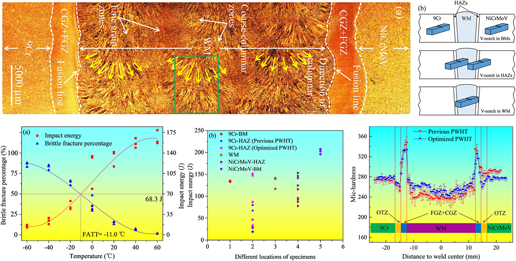Crossref Citations
This article has been cited by the following publications. This list is generated based on data provided by
Crossref.
Ding, Kai
Wang, Peng
Liu, Xia
Li, Xiaohong
Zhao, Bingge
and
Gao, Yulai
2018.
Formation of Lamellar Carbides in Alloy 617-HAZ and Their Role in the Impact Toughness of Alloy 617/9%Cr Dissimilar Welded Joint.
Journal of Materials Engineering and Performance,
Vol. 27,
Issue. 11,
p.
6027.
Li, Yifei
Cai, Zhipeng
Li, Kejian
Pan, Jiluan
Liu, Xia
Sun, Lingen
and
Wang, Peng
2018.
Investigation of local brittle zone in multipass welded joint of NiCrMoV steel with heavy section.
Journal of Materials Research,
Vol. 33,
Issue. 8,
p.
923.
Xu, Ke
Wang, Xiongfei
Cui, Haichao
and
Lu, Fenggui
2019.
Investigation on LCF Behavior of Welded Joint at Different Temperatures for Bainite Steel.
Chinese Journal of Mechanical Engineering,
Vol. 32,
Issue. 1,
Ding, Kai
Qiao, Shangfei
Liu, Shuping
Zhao, Bingge
Huo, Xin
Li, Xiaohong
and
Gao, Yulai
2019.
Failure Transition Mechanism of Stress Rupture Performance of the Inconel 625/9 Pct Cr Steel Dissimilar Welded Joint.
Metallurgical and Materials Transactions A,
Vol. 50,
Issue. 10,
p.
4652.
Ding, Kai
Zhao, Bingge
Huo, Xin
Fan, Manjie
Li, Xiaohong
Zhang, Yuanheng
Wei, Tao
Wu, Guanzhi
and
Gao, Yulai
2020.
Role of the V-Notch Location in the Impact Toughness of 9 Pct Cr-CrMoV Dissimilar Welded Joints.
Metallurgical and Materials Transactions A,
Vol. 51,
Issue. 4,
p.
1699.
Ding, Kai
Zhao, Bingge
Zhang, Yuanheng
Wei, Tao
Wu, Guanzhi
Wang, Yuanfang
and
Gao, Yulai
2020.
Characterization of Minerals, Metals, and Materials 2020.
p.
291.
Fang, Tao
Liu, Xia
Shao, Chendong
Cui, Haichao
and
Lu, Fenggui
2020.
Role of tempering cooling rate on impact toughness of 2CrMoV weld metal.
Journal of Materials Research,
Vol. 35,
Issue. 12,
p.
1612.
Zhang, Tianyi
Liu, Wei
Dong, Baojun
Wu, Yongjun
Yang, Weijian
Zhao, Yonggang
Fan, Yueming
and
Chen, Longjun
2022.
Determining on welding methods and parameters for the 3%Ni steel welded joints-insights into the corrosion resistance of the fusion zone.
Materials Chemistry and Physics,
Vol. 276,
Issue. ,
p.
125365.
Wang, Qi
Shao, Chendong
Cui, Haichao
Gao, Yuan
and
Lu, Fenggui
2022.
Effect of Carbon Migration on Interface Fatigue Crack Growth Behavior in 9Cr/CrMoV Dissimilar Welded Joint.
Acta Metallurgica Sinica (English Letters),
Vol. 35,
Issue. 5,
p.
714.
Li, Yao
Lu, Pengmin
Wang, Binhua
Hu, Xiaozhi
Li, Datao
and
Xiang, Qingyi
2022.
Evaluation of the fracture toughness of butt-welded joints using the boundary effect model.
Engineering Fracture Mechanics,
Vol. 274,
Issue. ,
p.
108777.
Li, Jiahui
Li, Yipeng
Liu, Dan
Ding, Yuming
Cui, Haichao
Tang, Xinhua
and
Lu, Fenggui
2023.
The Influence of Microstructure Evolution in Thick Plate 9%Ni Steel Submerged Arc Welding Joint on Fracture Toughness Properties.
Journal of Materials Engineering and Performance,
Ding, Kai
Fan, Manjie
He, Yi
Huo, Xin
Liu, Xia
Wei, Tao
Wu, Guanzhi
and
Gao, Yulai
2023.
Microstructure evolution and its effect on the stress rupture behavior of 9%Cr-CrMoV dissimilar welded joint.
Engineering Failure Analysis,
Vol. 146,
Issue. ,
p.
107071.
Zhang, Tianyi
Liu, Wei
Dong, Baojun
Yang, Weijian
Chen, Longjun
Sun, Yipu
Li, Hai
and
Zhang, Bo
2023.
Clarifying the effect of Cu element on the corrosion properties of Ni-Mo low alloy steel in marine environment.
Corrosion Science,
Vol. 216,
Issue. ,
p.
111107.




